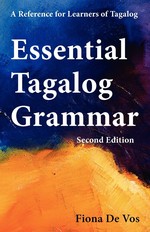The Tagalog POD and the English Subject
Note: To understand why we use the term POD, see The Tagalog focus, subject or Point of Departure (POD).
In many cases, the Tagalog POD corresponds to the English subject. Examples:
|
Kumain ng ice cream si Mary. |
Mary ate ice cream. |
|
Pumunta sa teacher si Mary. |
Mary went to the teacher. |
However, there are also many cases in which the Tagalog POD does not correspond to the English subject. Examples:
|
Kinain ni Mary ang ice cream. |
Mary ate the ice cream. Lit. The ice cream was eaten by Mary. |
|
Pinuntahan ni Mary ang teacher. |
Mary went to the teacher. Lit. The teacher was gone to by Mary. |
Some of the main differences between the Tagalog POD and the English subject:
1. The Tagalog POD generally comes after the News. The English subject comes before the predicate.
|
Kumain ng ice cream si Mary. |
Mary ate ice cream. |
|
Pumunta sa teacher si Mary. |
Mary went to the teacher. |
2. The English subject is usually the doer or “experiencer”* of the action. The Tagalog POD may be the doer/experiencer, object, direction etc. of the action.
|
Kumain ng ice cream si Mary. (POD – doer) |
Mary ate ice cream. |
|
Kinain ni Mary ang ice cream. (POD – object) |
Mary ate the ice cream. Lit. The ice cream was eaten by Mary. |
|
Pumunta sa teacher si Mary. (POD – doer) |
Mary went to the teacher. |
|
Pinuntahan ni Mary ang teacher. (POD – direction) |
Mary went to the teacher. Lit. The teacher was gone to by Mary. |
* Example of a Tagalog POD and English subject as experiencer of the action:
|
Nagulat si Mary. |
Mary was startled. |
3. The Tagalog POD is usually either definite (e.g. the dog, your dog, that dog, John) or generic (e.g. dogs in general).
|
Pinsan ni Mary si John. |
John is Mary’s cousin. |
|
Mammal ang balyena. |
Whales (in general) are mammals. |
|
Masarap ang ice cream. |
The ice cream is delicious. Ice cream (in general) is delicious. |
It is not uncommon for an English subject to be indefinite (e.g. a dog, some dogs).
A
bridge will be built here.
A
wallet has been found.
The Tagalog equivalent is generally expressed using a POD-less sentence indicating existence (There’s a…).
|
May tulay na itatayo’ dito. |
A bridge will be built here. Lit. There’s a bridge that will be built here. |
|
May wallet na nahanap. |
A wallet has been found. Lit. There’s a wallet that has been found. |
See also: Sentences with no POD (p. 371), May, mayroon/meron, marami, wala’ (p. 334)
4. If the object of an action in a basic sentence is definite, it becomes the POD in Tagalog. But it does not have to be the subject in English.
|
Kumain ng ice cream si Mary.
|
Mary ate (some) ice cream. (ice cream – indefinite object) |
|
Kinain ni Mary ang ice cream.
|
Mary ate the ice cream. Lit. The ice cream was eaten by Mary. (the ice cream – definite object) |
5. Certain other English subjects have no equivalent Tagalog POD.
|
Umuulan.
|
It’s raining. Lit. Raining. |
Please respect copyright. Learn more
Contents | Detailed Contents | Up ▲
See notes on Terminology and Pronunciation Marks
